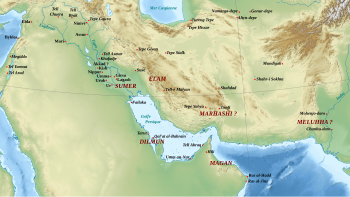 | |
| Location | Eastern Arabia |
|---|---|
| Region | Northern Governorate |
| Type | Ancient |
| Part of | Eastern Arabia |
| History | |
| Founded | c. late 4th millennium BC[1] |
| Abandoned | c. 538 BC[2] |
| Periods | Bronze Age |
Dilmun, or Telmun,[3] (Sumerian: ![]() ,[4][5] later 𒉌𒌇(𒆠), NI.TUKki = dilmunki; Arabic: دلمون) was an ancient East Semitic-speaking civilization in Eastern Arabia mentioned from the 3rd millennium BC onwards.[6][7] Based on contextual evidence, it was located in the Persian Gulf, on a trade route between Mesopotamia and the Indus Valley civilisation, close to the sea and to artesian springs.[1][8] Dilmun encompassed Bahrain,[9] Kuwait,[10][11][12] and eastern Saudi Arabia.[13]
,[4][5] later 𒉌𒌇(𒆠), NI.TUKki = dilmunki; Arabic: دلمون) was an ancient East Semitic-speaking civilization in Eastern Arabia mentioned from the 3rd millennium BC onwards.[6][7] Based on contextual evidence, it was located in the Persian Gulf, on a trade route between Mesopotamia and the Indus Valley civilisation, close to the sea and to artesian springs.[1][8] Dilmun encompassed Bahrain,[9] Kuwait,[10][11][12] and eastern Saudi Arabia.[13]
The great commercial and trading connections between Mesopotamia and Dilmun were strong and profound to the point where Dilmun was a central figure to the Sumerian creation myth.[14] Dilmun was described in the saga of Enki and Ninhursag as pre-existing in paradisiacal state, where predators do not kill, pain and diseases are absent, and people do not get old.[14]
Dilmun was an important trading centre. At the height of its power, it controlled the Persian Gulf trading routes.[1] According to some modern theories, the Sumerians regarded Dilmun as a sacred place,[15] but that is never stated in any known ancient text. Dilmun was mentioned by the Mesopotamians as a trade partner, a source of copper, and a trade entrepôt.
The Sumerian tale of the garden paradise of Dilmun may have been an inspiration for the Garden of Eden story.[16][17][18]
- ^ a b c Jesper Eidema, Flemming Højlund (1993). "Trade or diplomacy? Assyria and Dilmun in the eighteenth century BC". World Archaeology. 24 (3): 441–448. doi:10.1080/00438243.1993.9980218.
- ^ Cite error: The named reference
Larsonwas invoked but never defined (see the help page). - ^ The former is the reconstructed Sumerian pronunciation; the latter is the reconstructed Semitic.
- ^ Transliteration: "CDLI-Found Texts". cdli.ucla.edu.
- ^ Similar text: "CDLI-Found Texts". cdli.ucla.edu.
- ^ Smith, Sylvia (2013-05-21). "Bahrain digs unveil one of oldest civilizations". BBC News. BBC.
- ^ "Qal'at al-Bahrain – Ancient Harbour and Capital of Dilmun". UNESCO. Retrieved 17 August 2011.
- ^ Harriet E. W. Crawford (1998). "Dilmun and Its Gulf Neighbors". p. 9.
- ^ "The Invention of Cuneiform: Writing in Sumer". Jean-Jacques Glassner. 1990. p. 7.
- ^ Archived at Ghostarchive and the Wayback Machine: "Kuwait's archaeological sites reflect human history & civilizations (2:50 – 3:02)". Ministry of Interior News. 2 November 2013.
- ^ Calvet, Yves (1989). "Failaka and the Northern Part of Dilmun". Proceedings of the Seminar for Arabian Studies. 19: 5–11. JSTOR 41223078.
- ^ "The Archaeology of Kuwait" (PDF). Cardiff University. pp. 5–427.
- ^ "Prehistory and Protohistory of the Arabian Peninsula: Bahrain". M. A. Nayeem. 1990. p. 32.
- ^ a b The Arab world: an illustrated history p.4
- ^ Rice, Michael (2004). Egypt's Making: The Origins of Ancient Egypt 5000–2000 BC. Routledge. ISBN 978-1-134-49263-3., page 230
- ^ Edward Conklin. Getting Back Into the Garden of Eden. p. 10.
- ^ Kramer, Samuel Noah (1961). Sumerian Mythology: A Study of Spiritual and Literary Achievement in the Third Millennium B.C.: Revised Edition. Philadelphia, Pennsylvania: University of Pennsylvania Press. pp. 54–59. ISBN 978-0-8122-1047-7. Retrieved 21 May 2017.
- ^ Kramer, Samuel Noah (1963). The Sumerians: Their History, Culture, and Character. Chicago, Illinois: University of Chicago Press. pp. 145–150. ISBN 978-0-226-45238-8.
In fact, there is some reason to believe that the very idea of a paradise, a garden of the gods, originated with the Sumerians.